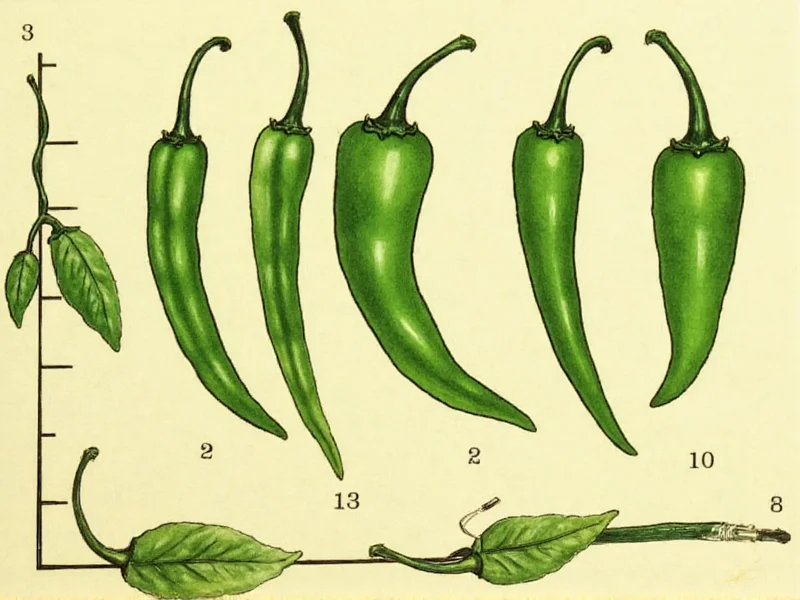Understanding where jalapeños fall on the Scoville scale provides valuable context for cooking, gardening, and enjoying these popular peppers. The Scoville scale, developed by pharmacist Wilbur Scoville in 1912, measures the concentration of capsaicinoids—the compounds responsible for a pepper's heat—in Scoville Heat Units (SHU). This standardized measurement helps consumers and chefs anticipate the spiciness of different chili varieties.
Understanding Jalapeño Heat Range
Jalapeños occupy a specific range on the Scoville scale that reflects their position as one of the most accessible hot peppers for everyday cooking. Their 2,500-8,000 SHU rating means:
- A single jalapeño typically delivers noticeable heat without overwhelming most palates
- They're approximately 8-128 times milder than the average habanero (100,000-350,000 SHU)
- They're about 2-8 times hotter than poblanos (1,000-2,000 SHU)
- They're significantly milder than cayenne peppers (30,000-50,000 SHU)
This moderate heat level explains why jalapeños have become so popular worldwide—they provide a flavorful kick that most people can enjoy without extreme discomfort.
Factors Influencing Jalapeño Heat Levels
Several variables affect where individual jalapeños fall within their 2,500-8,000 SHU range:
| Factor | Effect on Heat Level | Scientific Explanation |
|---|---|---|
| Stress conditions | Increases heat | Water deprivation or nutrient stress triggers higher capsaicin production as a defense mechanism |
| Ripeness | Increases heat | Red jalapeños (fully ripe) contain more capsaicin than green ones |
| Genetic variation | Varies significantly | Different cultivars like 'Early Jalapeno' or 'Jalafuego' have distinct heat profiles |
| Seed and membrane content | Major impact | Over 80% of capsaicin concentrates in the white pith surrounding seeds |
Jalapeños in Context: Scoville Scale Comparison
Understanding jalapeño heat requires perspective. The following comparison shows where jalapeños fit among common peppers:
| Pepper Variety | Scoville Heat Units (SHU) | Relative Heat to Jalapeño |
|---|---|---|
| Bell Pepper | 0 SHU | 0x (no heat) |
| Poblano | 1,000-2,000 SHU | ½ to ⅔ as hot |
| Jalapeño | 2,500-8,000 SHU | Baseline |
| Serrano | 10,000-23,000 SHU | 2-4x hotter |
| Cayenne | 30,000-50,000 SHU | 6-10x hotter |
| Habanero | 100,000-350,000 SHU | 20-50x hotter |
| Ghost Pepper | 855,000-1,041,427 SHU | 150-300x hotter |
Practical Implications of Jalapeño Heat Level
The 2,500-8,000 SHU range of jalapeños has significant implications for culinary use:
When cooking with jalapeños, remember that heat distribution isn't uniform. The placenta (white membrane surrounding seeds) contains most capsaicin, while the flesh has minimal heat. Removing seeds and membranes can reduce heat by up to 80% without sacrificing flavor. For those sensitive to spice, wearing gloves while handling jalapeños prevents capsaicin transfer to sensitive skin areas.
Interestingly, jalapeño heat perception varies by individual. Genetic differences in TRPV1 receptors (which detect capsaicin) mean some people experience the same jalapeño as significantly hotter than others. This biological variation explains why "mild" jalapeños might seem hot to some consumers.
Common Misconceptions About Jalapeño Heat
Several myths persist about jalapeño heat levels on the Scoville scale:
Many believe that smaller jalapeños are always hotter, but size correlates poorly with heat. The presence of 'corking'—those white stretch marks on the pepper's surface—actually indicates higher stress during growth and often corresponds to greater heat. Contrary to popular belief, refrigeration doesn't reduce jalapeño heat; it may even concentrate capsaicin as the pepper ages.
Understanding these nuances helps consumers make informed choices when selecting jalapeños for specific culinary applications, whether they're making mild stuffed peppers or fiery hot sauces where jalapeno scoville units comparison becomes essential.
How many Scoville units is a typical jalapeño?
A typical jalapeño measures between 2,500 and 8,000 Scoville Heat Units (SHU). Most commercially available jalapeños fall in the 3,500-5,000 SHU range, making them mild to medium-hot peppers that most people can enjoy without extreme discomfort.
Why do some jalapeños taste hotter than others?
Jalapeño heat varies due to growing conditions, ripeness, and genetics. Stress factors like water deprivation increase capsaicin production. Red jalapeños (fully ripe) are typically hotter than green ones. The white membrane surrounding seeds contains most capsaicin, so peppers with more membrane or left on the plant longer tend to be hotter.
How does jalapeño heat compare to other common peppers?
Jalapeños (2,500-8,000 SHU) are about 2-8 times hotter than poblanos (1,000-2,000 SHU), but 6-10 times milder than cayenne peppers (30,000-50,000 SHU). They're significantly milder than habaneros, which are 20-50 times hotter. Serranos, often confused with jalapeños, are typically 2-4 times hotter than their jalapeno pepper heat level scoville counterparts.
Can you reduce the heat of jalapeños for cooking?
Yes, you can significantly reduce jalapeño heat by removing the seeds and white membrane (placenta), where over 80% of capsaicin concentrates. Soaking sliced jalapeños in salt water or dairy products like milk can also neutralize some capsaicin. For milder stuffed jalapeños, choose larger specimens which often have thinner membranes and less concentrated heat.
Are red jalapeños hotter than green jalapeños?
Generally yes. Red jalapeños are simply fully ripened green jalapeños, and as they mature, capsaicin concentration increases. Red jalapeños typically measure toward the higher end of the 2,500-8,000 SHU range. However, heat can vary more by growing conditions than color alone, so some green jalapeños might be hotter than certain red ones depending on stress factors during cultivation.











 浙公网安备
33010002000092号
浙公网安备
33010002000092号 浙B2-20120091-4
浙B2-20120091-4